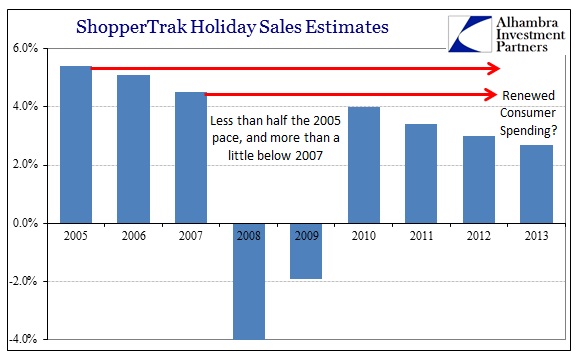Summing up the holiday season, we keep hearing about resilient consumers as estimated sales come in a little better than anticipated earlier, while retailers purportedly are relieved despite limited incomes and a drop in actual traffic. And the entire season was marked by discounts, but in this final analysis that was supposed to be a positive factor.
The gain exceeded the projection of a 3.6 percent increase, ShopperTrak said in a statement today. Customer visits dropped 2.7 percent during November and December from a year earlier, the firm said.
Sales were helped by a surge in spending the final weekend before the Christmas holiday, ShopperTrak said. Wal-Mart Stores Inc., Macy’s Inc. and Kohl’s Corp. offered last-minute promotions to attract cash-strapped shoppers…
Because the widespread discounting finally lured shoppers into malls, ShopperTrak was brimming with optimism about the economy in the after-holiday period.
“The holiday [season] retail sales performance overwhelmingly proves the U.S. consumer is resilient,” noted Bill Martin, co-founder of ShopperTrak. “Based on stagnant traffic and various economic concerns, retailers were understandably a bit nervous heading into the season, but the strength of Black Friday weekend added to the shopping surge experienced on Super Saturday helped sales exceed our expectations.”
So the discounting process drew fewer people to shop, but those Americans eventually and relectantly did so and expanded retailer fortunes. Individually, November sales were up 6% while December was only 3.5% above the year earlier. That certainly seemed to reinforce the theme that shoppers were fickle, but ultimately spent when the economy really needed it. In that narrow view, optimism was at least plausible.
The problem here is that while it sounds very much like the just completed holiday season, the above figures and quotes were disseminated in January 2008 regarding the 2007 Christmas season as the economy was beginning the first leg of recession. Only those economists unaware or intentionally obtuse were unable to see the larger trajectory. Though sales were nominally higher in Christmas 2007, the trend was clearly lower by almost every unbiased measure.
The most current figures just released by ShopperTrak for 2013 are accompanied, as you might expect, with similar views of “resilient US consumers.”
“We will continue to see the trend of steady sales increases as consumer confidence rises and the economy progresses,” said Martin.
For the record, 2013 Christmas holiday shopping, as measured by ShopperTrak is estimated to have increased 2.7% over 2012. That’s significantly less than even 2007’s moribund results. Even the growth in Black Friday sales, including the stores open on Thanksgiving, were well below the pace of Black Friday sales in both 2007 and 2008 (+8% and +3%, respectively).
As expected by those outside the industry and QE’s hypnosis, this segment of holiday sales saw the lowest growth of the “recovery” period.
Only those observers devoid of context or carrying a conflict of interest would be considerably optimistic based on these numbers. The best that can be said here is that the 2013 season wasn’t as bad as 2008 or 2009, but that’s an exceedingly low standard (though what we have come to expect in this “new normal”).
The real problem here, as noted over and over, is that retailers did not order and carry inventory levels based on the “lowest since 2009” holiday season. Instead, the current figures pretty much confirm the economic trajectory established since the middle of 2012 – the long and slow slide that increasingly looks like the European recession circa late 2011/early 2012.
Click here to sign up for our free weekly e-newsletter.
“Wealth preservation and accumulation through thoughtful investing.”
For information on Alhambra Investment Partners’ money management services and global portfolio approach to capital preservation, contact us at: jhudak@4kb.d43.myftpupload.com


Stay In Touch